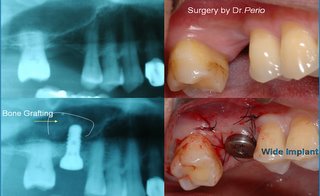Dental implants placement in conjunction with osteotome sinus floor elevation

Dental implants placement in conjunction with osteotome sinus floor elevation: a 12-year life-table analysis from a prospective study on 588 ITI®implants
Authors: Ferrigno, Nicola1; Laureti, Mauro1; Fanali, Stefano1
Source: Clinical Oral Implants Research, Volume 17, Number 2, April 2006, pp. 194-205(12)
Publisher:Blackwell Publishing
The purpose of this prospective study was to evaluate the clinical success of placing ITI dental implants in the posterior maxilla using the osteotome technique. Material and methods:
All implants were placed following a one-stage protocol (elevating the sinus floor and placing the implant at the same time). Five hundred and eighty-eight implants were placed in 323 consecutive patients with a residual vertical height of bone under the sinus ranging from 6 to 9 mm. The mean observation follow-up period was 59.7 months (with a range of 12–144 months). This prospective study not only calculated the 12-year cumulative survival and success rates for 588 implants by life-table analysis but also the cumulative success rates for implant subgroups divided per implant length and the percentage of sinus membrane perforation were evaluated. Results:
The 12-year cumulative survival and success rates were 94.8% and 90.8%, respectively. The analysis of implant subgroups showed slightly more favourable cumulative success rates for 12 mm long implants (93.4%) compared with 10 and 8 mm long implants (90.5% and 88.9%, respectively). During the study period, only 13 perforations of the Schneiderian membrane were detected with a perforation rate of 2.2% (13 perforations/601 treated sites). Ten perforations out of 13 were caused during the first half of the study period and of these, seven were detected during the first 3 years of this prospective study.
Conclusion:
Based on the results and within the limits of the present study, it can be concluded that ITI implant placement in conjunction with osteotome sinus floor elevation represents a safe modality of treating the posterior maxilla in areas with reduced bone height subjacent to the sinus as survival and success rates were maintained above 90% for a mean observation period of ≈60 months. Shorter implants (8mm implants) did not significantly fail more than longer ones (10 and 12 mm implants): the differences were small compared with the number of events; hence, no statistical conclusion could be drawn. But, from the clinical point of view, the predictable use of short implants in conjunction with osteotome sinus floor elevation may reduce the indication for complex invasive procedures like sinus lift and bone grafting procedures .





0 Comments:
Post a Comment
<< Home